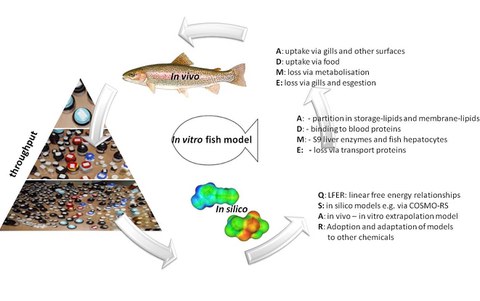In vitro Bioaccumulation
Thema: „Bilocation - Mechanistic approach for estimating and modeling the bioconcentration potential of charged and ionogenic organic chemicals via in vitro, in vivo and in silico methods“
Projektleiter: Prof. Stefan Stolte
Bearbeiter: Dr. Marta Markiewicz, Dr. Stephan Beil
Finanzierung: DFG
Laufzeit: 05/2018 - 07/2022
Bioaccumulation is of highest concern for environmental risk assessment of chemicals. Generally, the experimental measurement of bioaccumulation is time‐consuming, expensive, and due to ethical concerns regarding animal welfare not feasible for large sets of chemicals.
Thus, prediction models ‐ mainly based on easily determinable physicochemical properties such as the octanol‐water partition coefficient ‐ are used for the risk assessment.
The existing prediction models are applicable to hydrophobic and polar organic chemicals; however, they often give inappropriate and inaccurate results for ionogenic compounds and permanently charged organic chemicals. This is due to the fact that classical bioaccumulation models neither sufficiently consider ion–macromolecule interactions nor interactions of cations and anions in solution ‐ both strongly influencing the transport, uptake and bioavailability of ions.
The German Research Foundation (DFG) and National Science Centre (NCN) are supporting a Polish-German project between the University of Gdansk (Prof. Piotr Stepnowski) and the Technische Universität Dresden.
- main aim of our proposed project is to understand and predict the interactions of organic ions, and ion pairs in particular, with biological systems and their consequences in terms of bioaccumulation. Therefore a mechanistic approach applying several in vitro tests such membrane and storage lipid partitioning and protein binding is employed to achieve comprehensive data sets of charged and ionogenic compounds.
Read more about this topic in our recent publication:
Dołżonek J., Cho C.-W., Stepnowski P., Markiewicz M.,Thöming J., and Stolte S. (2017) Membrane partitioning of ionic liquid cations, anions and ion pairs – estimating the bioconcentration potential of organic ions. Environmental Pollution 228, 379-389.
Contact:
Dr. Stephan Beil
Dr. Marta Markiewicz

